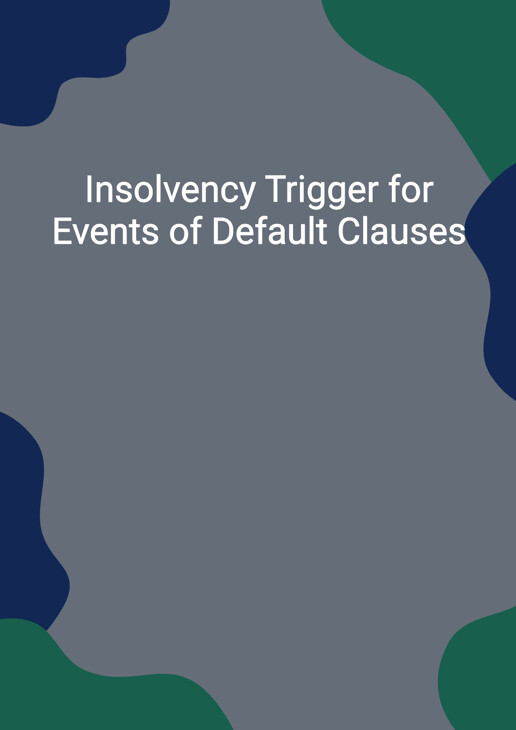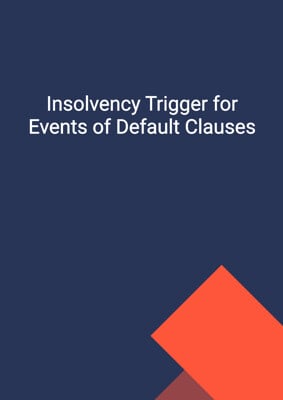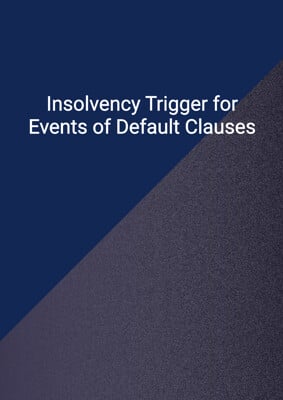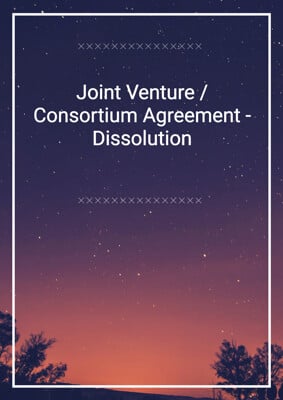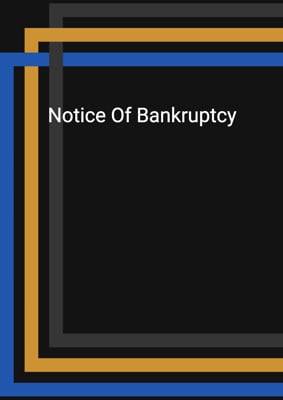How to Tailor the Document for Your Need?
01
Create Document
Click "Create Document" button and the document will be prepared with your account details automatically filled in.
02
Fill Information
Please fill in any additional information by following the step-by-step guide on the left hand side of the preview document and click the "Next" button.
03
Get Document
When you are done, click the "Get Document" button and you can download the document in Word or PDF format.
04
Review Document
Please review the document carefully and make any final modifications to ensure that the details are correct before publication / distribution.
Document Preview
Document Description
The document titled 'Insolvency Trigger for Events of Default Clauses' is of significant importance in contractual agreements as it outlines the conditions under which an event of default is triggered due to insolvency. The document consists of two sections: 'Insolvency' and 'Insolvency Proceedings'.
In the 'Insolvency' section, various scenarios are described that would indicate insolvency of any member of the group. These scenarios include:
(a) Inability to pay debts as they fall due or being deemed insolvent by law.
(b) Admission of inability to pay debts as they fall due.
(c) Suspension of debt payments or announcement of intention to do so.
(d) Commencement of negotiations with creditors for rescheduling of indebtedness due to financial difficulties.
(e) Declaration of a moratorium on any indebtedness.
It is important to note that if a moratorium is declared, the ending of the moratorium itself will not remedy any event of default caused by the moratorium.
The 'Insolvency Proceedings' section further elaborates on the actions or procedures that can be considered as insolvency proceedings. These include:
(a) Suspension of payments, moratorium, winding-up, dissolution, administration, or reorganization of any member of the group.
(b) Composition, assignment, or arrangement with any creditor of any member of the group.
(c) Appointment of various officers such as liquidator, trustee in bankruptcy, receiver, etc., in respect of any member of the group or its assets.
(d) Enforcement of security over any assets of any member of the group.
(e) Passing of a resolution by the relevant obligor or its directors to petition for winding-up or administration.
(f) Directors giving notice of intention to appoint an officer for liquidation, bankruptcy, etc.
(g) Any analogous procedure or step taken in any jurisdiction.
However, there are exceptions to the application of the 'Insolvency Proceedings' section. These exceptions include:
(a) A petition for winding-up presented by a creditor that is being contested in good faith and with due diligence and is discharged or struck out within 14 days.
(b) Solvent liquidation of any member of the group that is not an obligor.
(c) A transaction agreed by the majority creditors.
Overall, this document serves as a crucial reference point in determining events of default triggered by insolvency and provides clarity on the conditions and proceedings associated with it.
How to use this document?
To effectively use the 'Insolvency Trigger for Events of Default Clauses' document, follow the step-by-step guidance provided below:
1. Understand the concept of insolvency: Familiarize yourself with the definition and implications of insolvency as described in the document. This will help you grasp the importance of the events of default clauses related to insolvency.
2. Identify the 'Insolvency' section: Locate and read the 'Insolvency' section of the document. Pay close attention to the scenarios listed, such as inability to pay debts, suspension of payments, and declaration of a moratorium. Understand the significance of each scenario in triggering an event of default.
3. Explore the 'Insolvency Proceedings' section: Move on to the 'Insolvency Proceedings' section and carefully study the various actions and procedures mentioned. These include suspension of payments, appointment of officers, enforcement of security, and analogous procedures. Gain a clear understanding of how these proceedings can lead to events of default.
4. Note the exceptions: Take note of the exceptions mentioned in the document that limit the application of the 'Insolvency Proceedings' section. Understand the circumstances under which certain actions or procedures may not be considered as events of default.
5. Apply the knowledge to contractual agreements: Utilize the insights gained from the document to assess and draft events of default clauses related to insolvency in contractual agreements. Ensure that the clauses accurately reflect the conditions and proceedings outlined in the document.
6. Seek legal advice if needed: If you encounter any complexities or uncertainties while using the document, it is advisable to consult with a legal professional who specializes in contract law and insolvency. They can provide further guidance and ensure the clauses align with legal requirements.
By following these steps, you can effectively utilize the 'Insolvency Trigger for Events of Default Clauses' document in practical scenarios and ensure the inclusion of comprehensive and accurate clauses in contractual agreements.
Not the right document?
Don’t worry, we have thousands of documents for you to choose from:
